
Icelandic turf houses feature prominently in the country’s history, though few survive. Read on to learn about the history of turf houses in Iceland and where you can find them now.
Though the country was settled in 930 A.D. and has been inhabited ever since, you’ll be hard-pressed to find any buildings in Iceland that were built before the 19th century.
Why You Can Trust Our Content
Guide to Iceland is the most trusted travel platform in Iceland, helping millions of visitors each year. All our content is written and reviewed by local experts who are deeply familiar with Iceland. You can count on us for accurate, up-to-date, and trustworthy travel advice.
The island’s unique climate and landscape forced early Icelanders to be creative with construction techniques. Harsh, unpredictable weather, volcanic activity, isolation, and a lack of resources encouraged semi-permanent housing solutions.
The Icelandic turf house met these challenges by allowing Icelanders to move and rebuild easily when the need arose.
These buildings are among the few remaining relics that offer a vivid glimpse into what early Iceland was like. Turf houses are essential to understanding Iceland’s history and regularly remind locals of the hardships and determination of their ancestors. Yet many tourists miss out on the opportunity to explore them.
To truly appreciate these unique structures, many travelers choose to rent a car and visit them as part of self-drive tours. This flexible travel style allows you to venture beyond the typical tourist spots and discover hidden gems scattered across the countryside.
You’ll find turf houses near several popular regions, and there are plenty of accommodations in Iceland close to these historical sites, from cozy guesthouses to charming countryside hotels, making it easy to incorporate them into your itinerary.
Key Takeaways
-
Most turf houses in Iceland have been lost to the elements. Those that remain have been converted into museums.
-
Literary scholars generally agree that Iceland’s turf houses inspired the hobbit holes in J.R.R. Tolkien’s The Lord of the Rings trilogy.
-
Preserved turf houses are found throughout Iceland. No matter what region you’re visiting, you’ll be close to at least one.
- Check Out: The History of Icelandic Architecture
What Is a Turf House?
 Photo by Pierre-Axel Cotteret
Photo by Pierre-Axel Cotteret
Turf houses are semi-underground abodes with grass-covered roofs. Icelanders built them by stacking flat stones for the foundation, framing with birch or driftwood, and covering the structure with layers of turf.
A door marked the entrance, and some turf houses had small windows, mostly without glass (a rare commodity until modern times).
The appearance and architectural style of turf houses developed over time. Initially, they resembled classic Viking longhouses, complete with saunas.
In the 18th century, the burstabaer style emerged. These turf houses had wooden ends on both sides called gaflar, and a gable-style entrance. Almost all of the intact turf houses in Iceland today incorporate these features.
Why Turf Houses in Iceland Were Built This Way

Before human settlement, birch forests covered much of Iceland. But settlers quickly exhausted these woodlands.
Birch was mostly used for framing and doors, while turf became the primary building material. Norwegian settlers were already familiar with turf’s insulating properties, so they adapted their building methods to suit Iceland’s harsher climate and limited resources.
As the forests vanished, turf houses in Iceland evolved into complexes of smaller buildings linked by tunnels—a practical way to conserve heat and minimize the use of wood.
- See Also: The Forests of Iceland
What an Icelandic Turf House Interior Was Like
 The largest, most used space inside most turf houses was known as the badstofa (“bathing room”) — a communal room where families ate, lived, slept, and worked together. It was typically the warmest room in the home.
The largest, most used space inside most turf houses was known as the badstofa (“bathing room”) — a communal room where families ate, lived, slept, and worked together. It was typically the warmest room in the home.
Inhabitants prepared food in a hearth kitchen with a small hole in the roof for ventilation. This hole could be closed in bad weather with a sheep-gut lid stretched over a barrel ring.
While turf houses provided insulation, they lacked comfort. They were damp, smoke-filled, and dark, especially in winter. They were also often overcrowded, housing the entire family in addition to farmhands, seasonal workers, vagrants, and potentially state dependents.
The History of Turf Houses in Iceland

Due to Iceland’s geographic isolation, life in an Icelandic turf house changed very little as the centuries went by.
Though there were advancements in their construction, people continued to live traditional lives in these half-buried structures as the rest of Europe progressed toward industrialization.
Continuously eroded by the elements, turf houses required constant maintenance. Neglecting the house could lead to a collapse. This led many Icelanders to abandon their turf houses each year and build a new one.
Some Icelanders lived in natural fortresses such as borgarvirki or stone huts like those in Selatangar for the fishing season. Only the extremely impoverished or outlaws shunned by society risked sheltering in unstable caves.
As industrial-era technology reached Iceland, many people sold their farms, gathered their possessions, and abandoned their turf houses. Without maintenance, most of these historic homes eroded away, reclaimed by the earth from which they were made.
Preserving Iceland's Turf Houses
 To preserve this architectural heritage, the National Museum and other institutions began obtaining and restoring turf houses.
To preserve this architectural heritage, the National Museum and other institutions began obtaining and restoring turf houses.
Maintaining and reinforcing historic Icelandic houses presented a unique set of challenges. Most pressing was getting the turf to maintain its form in Iceland’s fickle climate.
As a result, learning how to build a turf house and repair existing structures became a respected craft.
Where To See Turf Houses in Iceland
 Despite so many turf homes lost to time, many of those that have been preserved are open to visitors.
Despite so many turf homes lost to time, many of those that have been preserved are open to visitors.
Some of the turf houses on this list have notable past occupants and fascinating histories, while others have greater cultural significance today, having reopened as museums. They are located all over the country, from popular tourist spots to far-flung, less-traveled locales.
Arbaer
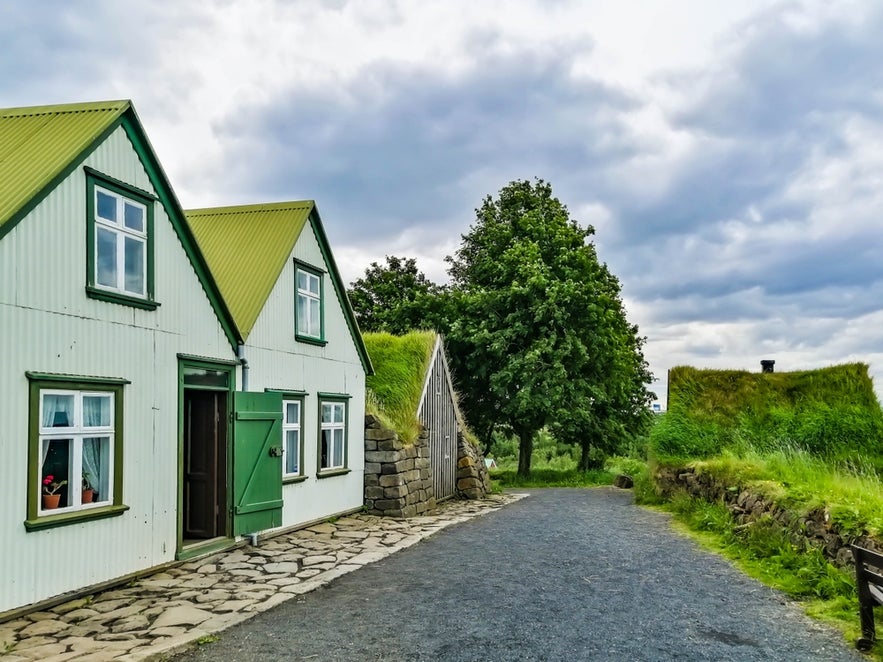 The Arbaer Turf House is conveniently located in Reykjavik, as part of the Arbaer Open Air Museum. The 20 buildings on the site tell the story of how Reykjavik transformed from sparse farmland to a capital city, and the museum features costumed guides and countless artifacts.
The Arbaer Turf House is conveniently located in Reykjavik, as part of the Arbaer Open Air Museum. The 20 buildings on the site tell the story of how Reykjavik transformed from sparse farmland to a capital city, and the museum features costumed guides and countless artifacts.
Some historians believe that the Arbaer Turf House dates back to 1226, although more concrete evidence dates its construction to 1464.
Visit the Arbaer Turf House at 459J+77, Kistuhylur 110, 110 Reykjavik, Iceland.
Arngrimsstofa

North Iceland maintains more preserved turf houses than any other region. Arngrimsstofa is one of the smallest, at about 54 square feet (5 square meters).
Local folk artist Arngrímur Gíslason built Arngrimsstofa in 1884. Officially rebuilt in 1983 to honor former President Kristján Eldjárn, it is owned by the National Museum and open to visitors.
You can find Arngrimsstofa at approximately 65.933789° N, 18.568142° W. Copy and paste these coordinates into Google Maps or your GPS to view the exact location and plan your visit.
Austur-Medalholt

Austur-Medalholt is a set of eight privately owned turf buildings on the South Coast filled with photos and artifacts documenting life in this kind of dwelling. The current buildings on the site date back to 1895, but there have been turf houses here for the past 400 years.
Austur-Medalholt was abandoned in 1965. The current owners bought and restored it and will happily show you around.
You can visit the Austur-Medalholt Turf House at Austur Medalholt, 803 Selfoss, Iceland.
Brattahlid & Bergsstadir
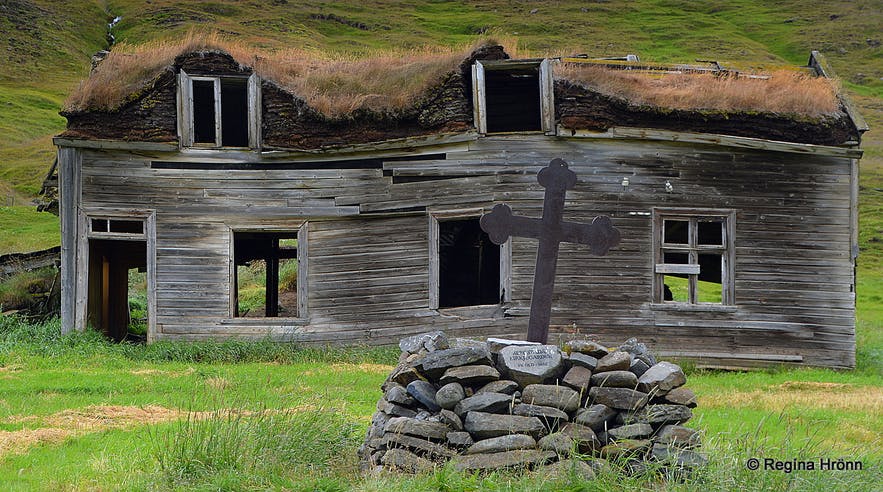
Brattahlid and Bergsstadir, both located in Svarfadardalur Valley, once offered a striking example of nature reclaiming traditional turf homes. Deserted in 1978, they gradually deteriorated over time. Unfortunately, Brattahlid has since been torn down, and Bergsstadir has collapsed.
Bustarfell
 Bustarfell, a large turf house in East Iceland, boasts beautiful surroundings and a fascinating history. The site was first settled in 1532, and the building was constructed in 1770, making it one of the oldest surviving turf houses in the country.
Bustarfell, a large turf house in East Iceland, boasts beautiful surroundings and a fascinating history. The site was first settled in 1532, and the building was constructed in 1770, making it one of the oldest surviving turf houses in the country.
You can visit the Bustarfell Museum at Bustarfell Hofsardalur, 690 Vopnafjordur, Iceland.
Note: The site is temporarily closed, so check for reopening updates before your visit.
Eiriksstadir
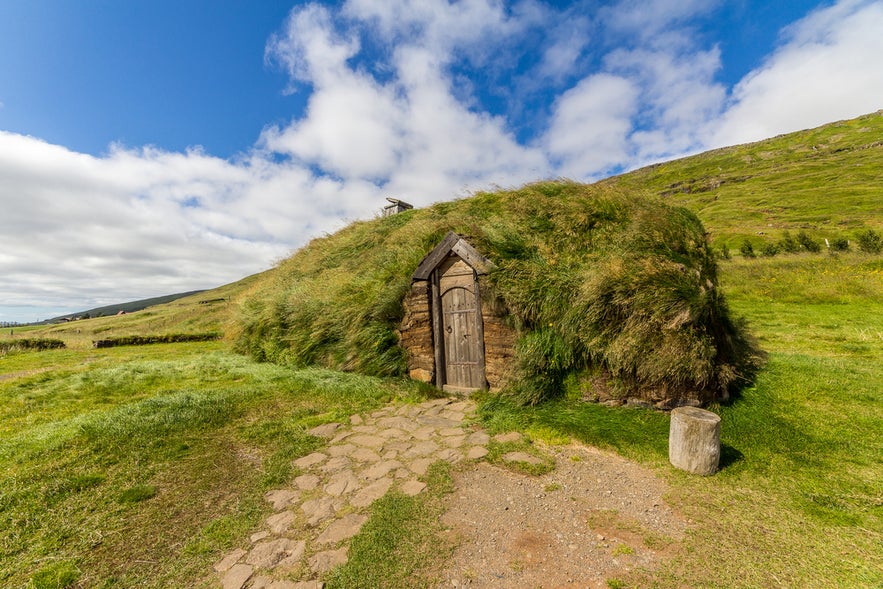 Eiriksstadir is a replica of the longhouse of Erik the Red, the notoriously violent Viking who stumbled upon Greenland. It stands in West Iceland, close to the excavated ruins of the original building.
Eiriksstadir is a replica of the longhouse of Erik the Red, the notoriously violent Viking who stumbled upon Greenland. It stands in West Iceland, close to the excavated ruins of the original building.
At Eiriksstadir, costumed staff will supply you with Viking attire, serve traditional Icelandic food, and let you handle swords and shields from the era. And, of course, they stand ready to recount the adventures of Erik the Red and his son, Leif Erikson, the Lucky, the first European to have visited North America.
Stop by the Eiriksstadir Longhouse at 3F56+FH Budardalur, Iceland.
- See Also: The Most Infamous Icelanders in History
Glaumbaer
 Located in Skagafjordur, North Iceland, Glaumbaer is one of the most historically important groups of turf houses in the country. Many pieces of literature and historical texts mention it, since several renowned chieftains lived or stayed here.
Located in Skagafjordur, North Iceland, Glaumbaer is one of the most historically important groups of turf houses in the country. Many pieces of literature and historical texts mention it, since several renowned chieftains lived or stayed here.
14 houses remain at Glaumbaer, and though most of the structures were built in the mid-19th century, elements date back to earlier times.
You can visit the Glaumbaer Turf Farm and Museum at JF6W+56 Varmahlid, Iceland.
Graenavatn

Graenavatn Turf House, built in 1913, stands near Lake Myvatn. Thus, it’s of a more modern style than most other turf houses, and its design reflects the transition at the time to a more comfortable way of life.
Adjacent to the house is a 150-year-old turf barn that contrasts quite dramatically with it. It is built in the traditional style, buried somewhat into the earth and covered in sod.
You can find Graenavatn Turf House at approximately 65°32.439'N, 16°59.802'W. Copy and paste these coordinates into Google Maps or your GPS to view its exact location and explore the surrounding area.
Grenjadarstadur

Grenjadarstadur Turf House in North Iceland has existed in one form or another since the country's settlement. The current residence was built in 1865 and deserted in 1949.
Today, the National Museum owns the stable and operates it as a service center for tourists. There, you can explore the interior of a turf building while you plan the rest of your trip.
You'll find the Grenjadarstadur Turf House at Adaldalur, Stadarbraut, 641 Husavik, Iceland.
Note: The site is temporarily closed, so check for reopening updates before your visit.
Keldur

South Iceland’s Keldur is a turf farm that dates back to the Icelandic Civil War and includes an underpass built as early as the 11th century. During the summer, guests are welcome at Keldur, which now operates as a museum.
You can visit the Keldur Turf House at Keldur, 851 Hella, Iceland.
Laufas
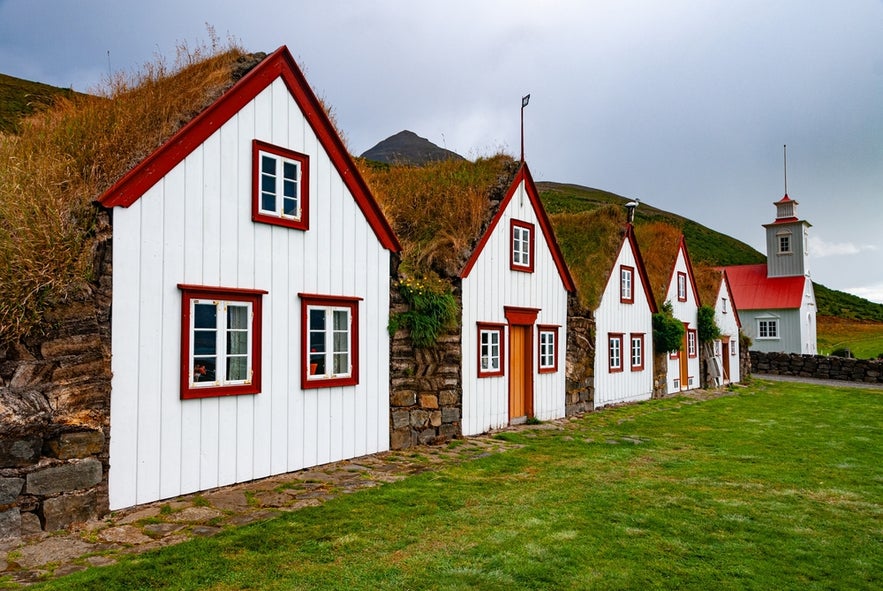 Now a museum, Laufas is a heritage site and turf farm located in Eyjafjordur, North Iceland. The buildings on the site were built between 1866 and 1877, but the site has been inhabited for over a millennium. Laufas is so ancient that it’s mentioned in Landnamabok, the Book of Settlement.
Now a museum, Laufas is a heritage site and turf farm located in Eyjafjordur, North Iceland. The buildings on the site were built between 1866 and 1877, but the site has been inhabited for over a millennium. Laufas is so ancient that it’s mentioned in Landnamabok, the Book of Settlement.
If you time your visit right, you can take part in one of the cultural celebrations hosted at Laufas, such as its annual Midsummer Festival in June. The free event features traditional music, crafts, dance, and more.
You'll find the Laufas Museum at Laufas, 610 Grytubakkahreppur, Iceland.
Note: The site is temporarily closed, so check for reopening updates before your visit.
- See Also: Iceland in June
Nyibaer
 Nyibaer is an unfurnished turf house in Holar, North Iceland. It was built in 1860, abandoned in 1945, and opened to the public by the National Museum in 1958. It is free to enter and is located at Prestsaeti 1, 551 Holar, Iceland.
Nyibaer is an unfurnished turf house in Holar, North Iceland. It was built in 1860, abandoned in 1945, and opened to the public by the National Museum in 1958. It is free to enter and is located at Prestsaeti 1, 551 Holar, Iceland.
Reynistadur
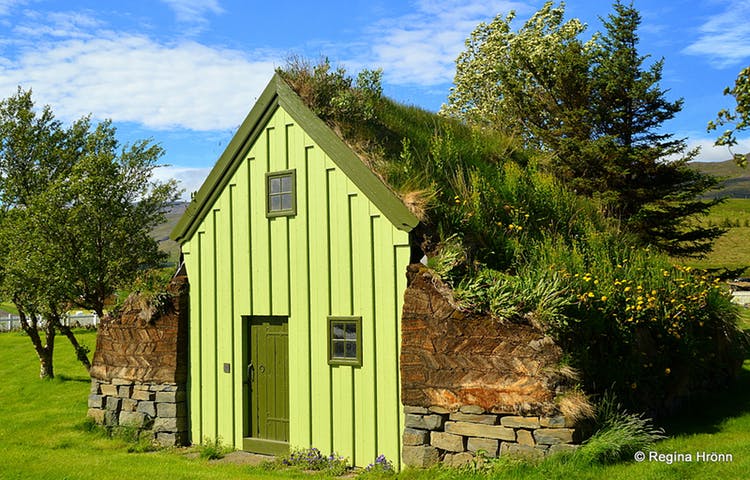
Dating back to the 10th century, Reynistadur housed famous chieftains. However, the turf farm on site was largely torn down in 1935, leaving only a turf gable behind.
This gable is well worth a visit if you’re in Skagafjordur. Its architecture, exemplary of the Middle Ages, harbors relics from this period.
You can find the Reynistadur Turf House at approximately 65°39'25.981"N, 19°33'39.863"W. Copy and paste these coordinates into Google Maps or your GPS to view the exact location and plan your visit.
Selid

Selid was constructed in 1912 and later restored by the National Museum. It’s nestled near the Skaftafell Nature Reserve, a fascinating part of the greater Vatnajokull National Park.
You can find Selid Turf House at approximately 64.0146707° N, 16.9739249° W. Copy and paste these coordinates into Google Maps or your GPS to view the exact location within the national park and plan your visit.
Skogar Turf Houses
 Skogar’s Turf Houses are just one part of the village’s cultural heritage museum. While the buildings themselves are reconstructions, parts of them date back to 1830.
Skogar’s Turf Houses are just one part of the village’s cultural heritage museum. While the buildings themselves are reconstructions, parts of them date back to 1830.
You can visit the Skogar Museum at Safnavegur 1, 861 Skogar, Iceland.
Storu-Akrar

The turf buildings at Storu-Akrar, located near the Midsida Farm in Skagafjordur Fjord, were originally built in 1745. They remain among the best-preserved examples of 18th-century Icelandic architecture.
You can find the Storu-Akrar Turf House at approximately 65°32'12.0"N, 19°19'01.5"W. Copy and paste these coordinates into Google Maps or your GPS to view the exact location and plan your visit.
Thvera
 Thvera is a set of nine turf houses in the Laxardalur Valley in North Iceland. It’s off the beaten path and thus overlooked by most visitors, making it a perfect destination for those looking to avoid crowds.
Thvera is a set of nine turf houses in the Laxardalur Valley in North Iceland. It’s off the beaten path and thus overlooked by most visitors, making it a perfect destination for those looking to avoid crowds.
Built between 1849 and 1851, Thvera was inhabited until 1964. Because the structures are so delicate, these dwellings can sometimes only be admired from the outside.
You can find the Thvera Turf House at approximately 65°43.912'N, 17°14.751'W. Copy and paste these coordinates into Google Maps or your GPS to view the exact spot and get directions.
Note: The site is temporarily closed, so check for reopening updates before your visit.
Thjodveldisbaerinn Stong
 Also known as the Commonwealth Farm, Thjodveldisbaerinn Stong is a reconstructed turf longhouse in South Iceland. The house it’s based on was likely destroyed in an eruption at Hekla Volcano in 1104. The new structure houses a museum of crafts and objects of interest from the period.
Also known as the Commonwealth Farm, Thjodveldisbaerinn Stong is a reconstructed turf longhouse in South Iceland. The house it’s based on was likely destroyed in an eruption at Hekla Volcano in 1104. The new structure houses a museum of crafts and objects of interest from the period.
You can visit the Commonwealth Farm at Thjodveldisbaerinn, 804 Selfoss, Iceland.
Tyrfingsstadir

Tyrfingsstadir is a private turf farm in Skagafjordur featuring five turf houses and five turf outhouses. Built in 1870, it was abandoned in 1969 before being bought and restored. Though you cannot enter the buildings here, you are welcome to admire them from the outside.
You can find Tyrfingsstadir Turf House at approximately 65°23.432'N, 19°07.511'W. Copy and paste these coordinates into Google Maps or your GPS to view the exact location and plan your visit.
Turf Churches in Iceland
Early Icelanders also used turf to build churches. As one of the most devout nations in Europe, Iceland has long had an unusually high number of churches per capita, a trend that continues today.
Five original turf churches remain in Iceland, mostly in the north. Visitors can also find a reconstructed turf church in the city of Reykjavik.
How To Get To Iceland’s Turf Houses
 Since turf houses are scattered across the country, you’re certain to find yourself close to at least one on many self-drive tours in Iceland.
Since turf houses are scattered across the country, you’re certain to find yourself close to at least one on many self-drive tours in Iceland.
Keep in mind when reviewing these itineraries that you may have to add some time to make your turf house visit.
-
7-Day Summer Self-Drive to North Iceland— This week-long self-drive tour focuses on North Iceland and the Arctic Coast Way, putting you on the path of several historic turf house sites.
-
10-Day Ring Road Self-Drive With Snaefellsnes — You’ll hit all the highlights of the Ring Road on this self-guided journey. Stops include Lake Myvatn, where you can visit the Graenavatn Turf House.
-
12-Day Ring Road Self-Drive With National Parks — This 12-day tour gives you even more time to explore preserved turf houses all around the Ring Road.
-
15-Day Summer Ring Road Self-Drive With Hot Springs — Embark on this two-week itinerary to maximize your time in Iceland and wander off the beaten path.
Frequently Asked Questions About Turf Houses in Iceland
We've compiled the most common questions to help you learn more about these historic structures.
When did turf houses first appear in Iceland?
Archaeologists believe that Norse settlers introduced turf houses to Iceland in the 9th century. Over time, they evolved to become the primary type of housing for Icelanders, especially in rural areas, until modern construction methods arrived in the 20th century.
How long did an Icelandic turf house last?
Turf houses could last for several decades, but their longevity depended on upkeep and weather conditions. The wooden frame and stone foundations were more durable, but the upkeep of the turf required constant maintenance.
What were the advantages of living in a turf house?
Turf houses offered several advantages: insulation, soundproofing, durability, and ready availability of materials.
How were turf houses furnished?
The interior of turf houses was simple and functional. Furniture was often made from wood, and the floors were sometimes covered with animal skins or woven mats.
People typically lived in small, cozy rooms, with a hearth or stove for cooking and warmth. Larger turf houses might have separate rooms for sleeping, cooking, and socializing.
Are turf houses unique to Iceland?
Turf houses are not unique to Iceland, but they are closely associated with the island's history and culture. Similar turf houses have been found in other Nordic-influenced countries, such as Norway, Greenland, and parts of Scotland.
However, the specific design and construction techniques used in Icelandic turf houses are distinct due to the island's unique climate and available resources.
A Worthwhile Step Back Into the Past

While Iceland’s turf houses may not be on the top of your sightseeing list, they’re a must for any history buff or Lord of the Rings fan. Those open to visitors have been thoughtfully and painstakingly preserved, and many offer a museum-like experience or even cultural festivals at certain times of the year.
For an even deeper dive into Iceland’s history and culture, explore the best museums in Iceland. You’ll find everything from Viking artifacts to modern art, with exhibits spread across the country.
Are you planning to visit a turf house on your trip? What do you think is special about them? Let us know in the comments.













